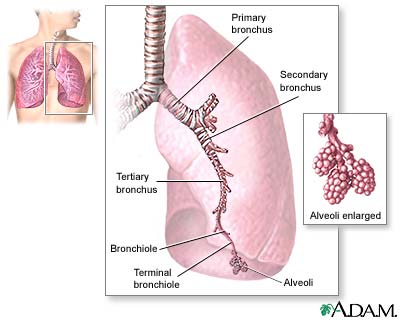Alternate Names : Black lung disease, Pneumoconiosis, Anthrosilicosis
Definition
Coal worker’s pneumoconiosis is a lung disease that results from breathing in dust from coal, graphite, or man-made carbon over a long period of time.
Overview, Causes, & Risk Factors
Coal worker’s pneumoconiosis occurs in two forms: simple and complicated (progressive massive fibrosis, or PMF).
Your risk of developing the disease depends on how long you have been around the coal dust. Most people with this disease are older than 50. Smoking does not increase your risk of developing this disease, but it may have an additional harmful effect on the lungs.
If complicated coal worker’s pneumoconiosis occurs along with rheumatoid arthritis, it is called Caplan syndrome.
Pictures & Images
Lungs
 The major features of the lungs include the bronchi, the bronchioles and the alveoli. The alveoli are the microscopic blood vessel-lined sacks in which oxygen and carbon dioxide gas are exchanged.
The major features of the lungs include the bronchi, the bronchioles and the alveoli. The alveoli are the microscopic blood vessel-lined sacks in which oxygen and carbon dioxide gas are exchanged.
Coal worker’s lungs – chest x-ray

This chest x-ray shows coal worker’s lungs. There are diffuse, small, light areas on both sides (1 to 3 mm) in all parts of the lungs. Diseases that may result in an x-ray like this include: simple coal workers pneumoconiosis (CWP) – stage I, simple silicosis, miliary tuberculosis, histiocytosis X (eosinophilic granuloma), and other diffuse infiltrate pulmonary diseases.
Coal workers pneumoconiosis – stage II

This chest x-ray shows stage II coal worker’s pneumoconiosis (CWP). There are diffuse, small light areas on both sides of the lungs. Other diseases�that may explain these x-ray findings include simple silicosis, disseminated tuberculosis, metastatic lung cancer, and other diffuse, infiltrative pulmonary diseases.
Coal workers pneumoconiosis, complicated

This picture shows complicated coal workers pneumoconiosis. There are diffuse, small, light areas (3 to 5 mm) in all areas on both sides of the lungs. There are large light areas which run together with poorly defined borders in the upper areas on both sides of the lungs. Diseases which may explain these X-ray findings include complicated coal workers pneumoconiosis (CWP), silico-tuberculosis, disseminated tuberculosis, metastatic lung cancer, and other diffuse infiltrative pulmonary diseases.
Respiratory system

Air is breathed in through the nasal passageways, travels through the trachea and bronchi to the lungs.
-
Coal worker’s pneumoconiosis : Overview, Causes, & Risk Factors
-
Coal worker’s pneumoconiosis : Symptoms & Signs, Diagnosis & Tests
-
Coal worker’s pneumoconiosis : Treatment



Review Date : 4/24/2009
Reviewed By : Allen J. Blaivas, DO, Clinical Assistant Professor of Medicine UMDNJ-NJMS, Attending Physician in the Division of Pulmonary, Critical Care, and Sleep Medicine, Department of Veterans Affairs, VA New Jersey Health Care System, East Orange, NJ. Review provided by VeriMed Healthcare Network. Also reviewed by David Zieve, MD, MHA, Medical Director, A.D.A.M., Inc.
